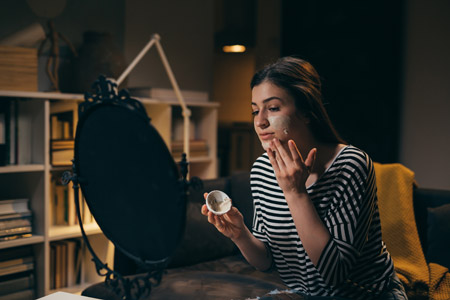


Determining Your Skin Type
Did you know that the largest organ in your body is actually your skin? Your skin, or dermis, gets exposed to the elements constantly, so it’s important to do your best to protect it.
One of the most important parts of building an effective skincare routine starts with knowing what your skin type is and what special considerations you need to make in the day-to-day care of your skin.
Keep reading for tips to determine what skin type you may have.
What Skin Types Are There?
Generally speaking, there are a few different skin types. Skin types include oily, dry, normal, sensitive, or combination.
- Oily: You may notice an excessive amount of oil on the skin, especially in the T-zone.
- Dry: You can see dry, cracked, or flakey patches of skin and a general lack of moisture in the skin.
- Combination: You notice both oily spots and dry patches on your skin.
- Sensitive: On top of having dry, oily, or combination skin, if you notice that many skincare products, makeups, or even environmental factors irritate your skin, you may have sensitive skin.
How Can I Tell What Skin Type I Have?
Step 1: Observe Your Skin’s Natural State
Using skincare products can mask what happens to your skin naturally. If you have a day where you can avoid going into the sunlight, wash your face, pat dry, and then observe what happens over the course of the day:
- Oily skin may look shiny and feel slick
- Dry skin will present with patches of dry, scaly, or flaky skin
- Combination skin may appear as a combo of both oily and dry
- Sensitive skin may present with redness or irritation in spots
Step 2: Use Oil Blotting Sheets
If a quick look at your skin isn’t enough to help tell which skin type you have, grab an oil blotting sheet about 30 minutes to an hour after washing your face. Press a sheet to your face — if little to no oil is picked up, you probably have dry skin. If a lot of oil is picked up, you probably have oily skin. If oil is mainly concentrated in your T-zone, you may have combination skin.
Step 3: See Your Dermatologist
If you still feel unsure about your skin type, it’s always good to check with your doctor or dermatologist to get an expert opinion. From there, your provider can suggest specific skin care routines and treatment types to address your skin’s unique needs.
The information on this site is for informational purposes only and should not replace direct medical advice, diagnosis, or treatment from your doctor or another qualified healthcare provider.
Sources:
“Know Your Skin Type Before Choosing Skin Care Products.” Cleveland Clinic.
“How to determine your skin type (and why it matters).“ SIU School of Medicine.



















.jpg)





















.jpg)

















.jpg)


























.jpg)
.jpg)
.jpg)













